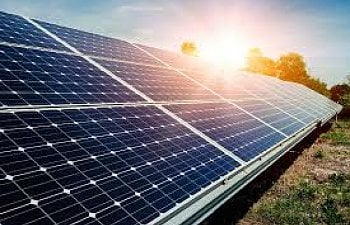
I have often wondered what I would do to feed my flock should circumstances arise which prevented me from purchasing pre-bagged formulated feed from the feed store. Hurricanes, floods, forest fires, other natural disasters, not to mention the world's shaky economy, any one of these scenarios could have you improvising on feeding your flock for a few weeks or several months. Some people even choose to live "off the grid" getting back to a more simpler time. (I am not going to take this article to "apocalyptic" proportions, not only would this make for a whole other article but this is not intended to be a lesson on preparedness or survival. It's more of a "what if something should happen" and of course to give you some ideas on new foods you may want to incorporate into your flock's diet.)
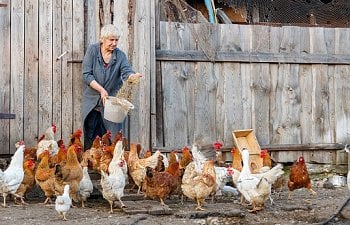
First, lets take a look back at how the farmers used to feed their flocks. Granted, these are modern times and many things have changed when it comes to keeping chickens. Farmers fed what ever was left over from table scraps, excess grains that would normally go to other livestock and of course chickens were constantly free ranging for food. Some days the chickens were fed well, other days they may not have met the necessary requirements. But it worked for the farmers. Back then chickens were raised for meat and eggs. Most birds were butchered after their 1st or 2nd year for food on the table, roosters mated with hens and the the broodies kept the flock's population stable. So how can we duplicate what the old timers did way back then should the need arise?!
Free Ranging:
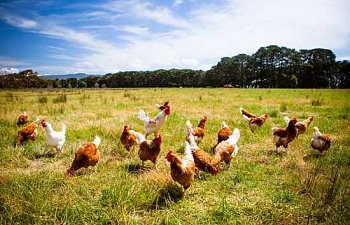
Free ranging is one of the first places to start. Chickens love it, it's great exercise for them and can really lower the feed bill. When the weather and season allows, chickens can find a great deal to eat out in the field. Their bodies tell them what they need and they will search it out whether it be bugs, tubers, certain vitamins, minerals or simple foliage. But what if the weather doesn't allow you to free range your flock? Or you live in a place where free ranging just doesn't provide enough due to drought or poor ranging territory?
What sort of things might we keep on hand just in case? Feeding pre-made manufactured feed ensures that your flock is getting vital vitamins, minerals and other nutrients from their feed, however we all know how fast pre-bagged feed can spoil or if nothing else go stale. So we can't keep too much of that on hand. So what else CAN we feed them during hard times and what do they really need to thrive?
Nutritional needs of chickens:
Protein- Required for the synthesis of body tissue (particularly muscle), physiological molecules (such as enzymes and hormones), feathers and for egg production. Proteins are complex compounds made up of smaller units called amino acids. After a bird consumes protein, the digestive process breaks down the protein into amino acids. The amino acids are then absorbed by the blood and transported to cells that convert the individual amino acids into the specific proteins required by the animal. Proteins are used in the construction of body tissues such as muscles, nerves, cartilage, skin, feathers, beak and so on. Egg white is also high in protein.
Carbohydrates- The major source of energy for poultry, most of the carbohydrates in poultry diets are provided by cereal grains.
Fats- Provide energy and essential fatty acids that are required for some bodily processes. Fat must be present in the diet for poultry to absorb the fat-soluble vitamins A, D, E, and K. In addition to its role in nutrition, fat is added to feed to reduce grain dust. Fat addition also improves the palatability of feed (that is, makes feed more appetizing).
Fiber- Soluble fiber dissolves in water and becomes a gelatinous form, which may help to slow digestion and help the body absorb vital nutrients from foods. Insoluble fiber stays in its fibrous form, helps food pass through the digestive system and adds bulk to the stool. Fiber is utilized by Lactobacillus and Bifidobacteria species which lead to production of lactic acid and short chain fatty acids. This lowers the PH of the intestinal tract helping to prevent the establishment of Salmonella and other pathogens.
Vitamins- Organic chemicals (chemicals containing carbon) which help control body processes and are required in small amounts for normal health and growth.
Minerals- Inorganic chemicals (chemicals not containing carbon) which help control body processes and are required for normal health and growth. Minerals play a role in bone formation, but minerals are also needed for several other important functions, including formation of blood cells, blood clotting, enzyme activation, and energy metabolism and for proper muscle function.
Water- Water regulates the body's temperature through sweating. Water is essential for the proper circulation of nutrients in the body. Water serves as the body's transportation system.
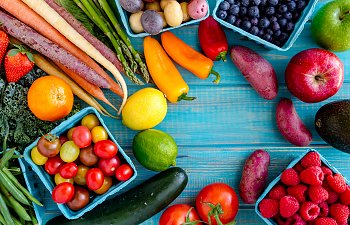
Below is a quick list of some foods you might keep on hand to feed your flock should you experience hard times. (Please stop by or Treats Chart here on BYC for more ideas.) You can grow these foods in your own garden and feed fresh or feed from canning, sprout seeds and grains, purchase canned foods (salt free canned foods only), bagged grains for homemade feed mixes, vitamin supplements, etc...
List of foods you can feed:
• Alfalfa hay- Alfalfa is typically high in vitamin K and also contains many other nutrients, including vitamin C, copper, manganese, calcium, potassium and folate and high in fiber. It is a source of vitamins A, C, E, and K4. Alfalfa sprouts contain the same nutrients.
• Apples- They are high in fiber and vitamin C, have only a trace of sodium and no fat or cholesterol. Apples are high in polyphenols, which function as antioxidants. They are a wonderful anti yeast food.
• Asparagus- This bright-green veggie is packed with vitamins and minerals like vitamins A, C, E, K, and B6, as well as folate, iron, copper, calcium, protein, and fiber.
• Bananas- Bananas are a source of potassium and fiber
• Beans- (cooked only)- Beans are a good source of Vitamin B6, Pantothenic Acid, Iron, Magnesium, Phosphorus and Potassium and a very good source of Protein, Vitamin C, Thiamine, Riboflavin, Niacin, Folate, Copper and Manganese. Contains high levels of needed methionine.
• Beets- This food is very low in Saturated Fat and Cholesterol. It is also a good source of dietary fiber, Vitamin C, Magnesium and Potassium, and a very good source of Folate and Manganese.
• Berries- Berries are loaded with antioxidants, fiber, regulates blood sugar
• Bread- Homemade breads, whole wheat breads. Whole meal bread contains the whole grain and provides fiber, vitamin B, and minerals.
• Broccoli- Broccoli offers as much vitamin C as an orange, and is a good source of beta-carotene. Broccoli contains vitamins B1, B2, B3, B6, iron, magnesium, potassium, and zinc too.
• Cabbage- Cabbage is an excellent source of vitamin K, vitamin C and vitamin B6. It is also a very good source of manganese, dietary fiber, potassium, vitamin B1, folate and copper. Additionally, cabbage is a good source of choline, phosphorus, vitamin B2, magnesium, calcium, selenium, iron, pantothenic acid, protein and niacin.
• Cantaloupe- Cantaloupe is a great source of vitamin K, niacin, vitamin B-6, folate, magnesium, and potassium.
• Carrots- Carrots are a good source of several vitamins and minerals, especially vitamin A (from beta-carotene), biotin, vitamin K (phylloquinone), potassium and vitamin B6 and Vitamin A. Carrots are rich in beta-carotene, which is converted to vitamin A in the body.
• Cat food- While cat food is formulated for cats, cat food can be fed in small amounts for high protein and many needed vitamins and minerals.
• Cauliflower- This food is very low in Saturated Fat and Cholesterol. It is also a good source of Protein, Thiamine, Riboflavin, Niacin, Magnesium and Phosphorus, and a very good source of Dietary Fiber, Vitamin C, Vitamin K, Vitamin B6, Folate, Pantothenic Acid, Potassium and Manganese.
• Cereal- Most cereals are balanced with added vitamins and minerals. However watch you don't feed cereals high in sugar or salt.
• Cheese- Cheese contains the goodness of a number of essential nutrients, including protein,calcium, zinc, phosphorus, magnesium, vitamin A, vitamin B2 (riboflavin) and vitamin B12. Contains high levels of needed methionine.
• Cooked meat (chicken, turkey, beef, other meats)- Meats contain protein, B vitamins (niacin, thiamine, riboflavin, and B6),vitamin E, iron, zinc, and magnesium. Proteins function as building blocks for bones, muscles, cartilage, skin, and blood. Contains high levels of needed methionine.
• Corn- Corn provides fiber, which aids in digestion, plus folate, thiamine, phosphorus, vitamin C, and magnesium. It is high in carbohydrates.
• Cucumber- Cucumbers are a good source of fiber, vitamin K, vitamin C, magnesium, potassium, manganese and vitamin A.
• Dog food- Same as with Cat food, Dog food can provide fairly balanced diet of protein and added vitamins and nutrients.
• Eggs (consider cooked eggs only, raw might encourage egg eating)- Along with milk, eggs contain the highest biological value (or gold standard) for protein. Eggs contain all the building blocks of life and is considered "Emergency Food" for birds, they could technically live on eggs for an extended period of time. Contains high levels of needed methionine.
• Eggshells-(lightly toasted) In addition to calcium and protein, eggshells also contain small amounts of other minerals, including strontium, fluoride, magnesium and selenium. Just like calcium, these minerals may play a role in bone health, the excess calcium for laying hard shelled eggs.
• Fish- Fish is filled with omega-3 fatty acids and vitamins such as D and B2 (riboflavin). Fish is rich in calcium and phosphorus and a great source of minerals, such as iron, zinc, iodine, magnesium, and potassium. Contains high levels of needed methionine.
• Grains- Corn, Oats, Barley and Wheat are widely used in processed chicken feed. Trace minerals, vitamins and carbohydrates, great for making homemade feeds.
• Grapes- A good source of vitamin K, copper and many of the B vitamins, they are also a good source of fiber.
• Greens- Lettuces, Kale, Mustard Greens, Collard Greens, Spinach, etc..high in vitamins A, C, B6, magnesium, iron and calcium.
• Grits- Grits are a source of protein, fiber and vitamin A. A good source of carbohydrates.
• Honeydew melon- Good source of vitamin C and has potassium content comparable to bananas. Honeydew is also a source of B vitamins thiamine, niacin, pantothenic acid, as well as the trace mineral copper.
• Kelp- Sea kelp is a natural source of vitamins A, B1, B2, C, D and E, as well as minerals including zinc, iodine, magnesium, iron, potassium, copper and calcium. In fact it contains the highest natural concentration of calcium of any food - 10 times more than milk. Kelp also contains a bit of salt which all things need for sustained life.
• Milk- Milk and dairy foods provide the right amount of bone-building nutrients, specifically calcium, vitamin D, protein, phosphorus, magnesium, potassium, vitamin B12 and zinc. Contains high levels of needed methionine.
• Oatmeal- Good source of fiber and protein. In addition to fiber, oatmeal is rich in thiamine, magnesium, phosphorus, zinc, manganese, selenium, and iron.
• Pasta- A good source of protein, fiber and carbohydrates.
• Peas- Green peas are a very good source of vitamin K, manganese, dietary fiber, vitamin B1, copper, vitamin C, phosphorus and folate. They are also a good source of vitamin B6, niacin, vitamin B2, molybdenum, zinc, protein, magnesium, iron, potassium and choline.
• Peppers- Bell peppers are very high in vitamin C. Other vitamins and minerals found in bell peppers include vitamin K1, vitamin E, vitamin A, folate, and potassium.
• Potato- (no green spots and must be cooked!) They are a good source of vitamins C and B6, manganese, phosphorus, niacin and pantothenic acid.
• Pumpkin- A good source of Vitamin E (Alpha Tocopherol), Thiamine, Niacin, Vitamin B6, Folate, Iron, Magnesium and Phosphorus, and a very good source of Dietary Fiber, Vitamin A, Vitamin C, Riboflavin, Potassium, Copper and Manganese.
• Quinoa- High in protein and one of the few plant foods that contain all nine essential amino acids. It is also high in fiber, magnesium, B vitamins, iron,potassium, calcium, phosphorus, vitamin E and various beneficial antioxidants.
• Raisins- Raisins can contain up to 72% sugars by weight, most of which is fructose and glucose. They also contain about 3% protein and 3.7%–6.8% dietary fiber. Raisins, like prunes and apricots, are also high in certain antioxidants, but have a lower vitamin C content than fresh grapes. Do not over feed raisins due to the high sugar content.
• Rice- White or brown rice is a good source of magnesium, phosphorus, manganese, selenium, iron, folic acid, thiamine and niacin. It is low in fiber and its fat content is primarily omega-6 fatty acids, which are considered pro-inflammatory.
• Sprouts and fodder- A good source of Protein, Vitamin A, Niacin and Calcium, and a very good source of Dietary Fiber, Vitamin C, Vitamin K, Thiamine, Riboflavin, Folate, Pantothenic Acid, Iron, Magnesium, Phosphorus, Zinc, Copper and Manganese.
• Squashes- Zucchini, Acorn squash, Spaghetti squash, other squashes. Squash a very good source of vitamin C, magnesium, dietary fiber, phosphorus, potassium, folate, vitamin B6 and vitamin K. Additionally, it is a good source of vitamin B1, zinc, omega-3 fatty acids, niacin, vitamin B2, pantothenic acid, calcium, iron, choline and protein.
• Sunflower and other small wild bird seeds- Benefits Sunflower seeds are rich in the B complex vitamins, which are essential for a healthy nervous system, and are a good source of phosphorus, magnesium, iron,calcium, potassium, protein and vitamin E. They also contain trace minerals, zinc,manganese, copper, chromium and carotene as well as monounsaturated fats. Other seeds such as Millet seed contains protein, dietary fiber, several B vitamins and numerous dietary minerals, especially manganese.
• Sweet potato- They contain a good amount of fiber as well as vitamin A, vitamin C, manganese and several other vitamins and minerals. In addition to the nutrients above, sweet potato nutrition also contains riboflavin, phosphorus, vitamin E, vitamin K, calcium and iron.
• Tomatoes- (do not feed the stems or leaves)- Tomatoes are the major dietary source of the antioxidant lycopene, which has been linked to many health benefits, including reduced risk of heart disease and cancer. They are also a great source of vitamin C, potassium, folate and vitamin K.
• Watermelon- has significant levels of vitamins A, B6 and C, lots of lycopene, antioxidants and amino acids. There's even a modest amount of potassium.
• Yogurt- calcium, vitamin B-2, B-12, potassium, and magnesium. Loaded with Probiotics.
No doubt you probably won't have all of these foods set up in your pantry or storage area, however from this list you could put together a variety of foods which contain enough Proteins, Carbohydrates, Fats, Vitamins and Minerals, a tiny bit of salt and probiotics to keep your flock doing during hard times.
(Things you should never feed chickens)
- Never, ever allow your chickens to eat dried or raw beans, ALWAYS cook thoroughly.
- Chickens should not eat anything moldy, buggy, smells bad, looks bad or something that you feel you yourself is unfit to eat.
- Parts of the avocado should not be eaten by chickens, so just avoid the entire thing.
- Chickens should not eat green or raw potatoes. ALWAYS cook potatoes thoroughly.
- No stems or leaves of the Tomato plant. Tomatoes themselves are ok.
- No Caffeine.
- Chickens should not eat chocolate.
- No foods that are overly salty or high in fat. Chickens do not process out salt easily and salt intoxication can result in death. High fat diets in chickens lead to Fatty Liver disease.
So what other things might we incorporate into our flocks diet?
Composting Piles:
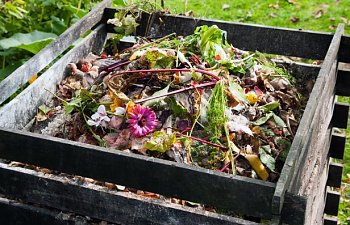
Compost piles are wonderful places for chickens to scratch around in. They not only turn the organic material but they will find all kinds of tasty treats in the pile! You can let them free range outside in the compost pile, some people keep the compost pile IN the run!
Sprouts and fodder:
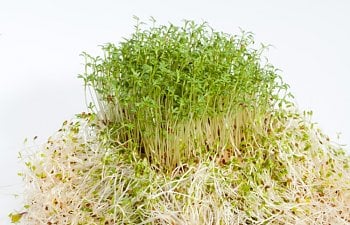
Learning how to sprout grains and seeds can boost the health of your flock greatly. Sprouting grains increases many of the grains' key nutrients, including B vitamins, vitamin C, folate, fiber, and essential amino acids often lacking in grains, such as Lysine. Nuts seeds, grains and beans are nutritional powerhouses. Soaking and sprouting them replicates germination which activates and multiplies nutrients (particularly Vitamins A, B, and C), neutralizes enzyme inhibitors and promotes the growth of vital digestive enzymes.
Basic Sprouting Techniques:
There are as many methods for sprouting as there are seeds to sprout. Any seed will sprout, from Millet, Chia, Alfalfa, wild bird seeds, to name a few, as along as they are whole seed. Follow specific instruction for sprouting your seed of choice or try one of these methods, a good general method for nearly any seed.
Sprouting in a jar: works well leafy sprouts like alfalfa.
Sprouting in a large tray or plate: works well leafy sprouts like alfalfa.
Sprouting in a sack: best method for larger seeds like beans, for better ventilation.
Sprouting in a bucket or large trays: works best for feed grains and making fodder.
Soaking your seeds or grains:
- Use raw, un-sprouted nuts, grains, seeds or legumes that haven’t been roasted, blanched or prepared yet at all in any other way.
- Place them in a bowl covered with several inches of water. Cover with a kitchen towel. Let them sit for anywhere between 5–48 hours depending on the kind of seed and how hard it is.
- If you soak for more than 12 hours, rinse the grains, nuts, seeds or beans every 12 hours to change the water. Use fresh water, and completely discard the water you had been soaking in previously.
- Do this every 12 hours for up to 48 hours.
- You’ll notice how much they’ve expanded at this point as they’ve soaked up a lot of water. That’s a good thing!
- Keep in the refrigerator, and use within the next few days since they now have the potential to spoil.
Directions to Sprout:
- If using jars, I like to cover the top with cheese cloth attached to the top of the jar with a rubber band to make it easier to rinse the sprouts. Rinsing not only keeps them moist but keeps them from becoming bitter. For rinsing sprouts in trays, strain and leave them out in a dish or shallow bowl on damp paper towels on the counter top, or somewhere where they will be exposed to air.
- Rinse sprouts several times a day rinsing with clean water, drain well.
- Sprouts vary from 1/8 inch to 2 inches long depending on what you are sprouting and usually take 4 or 5 days to full growth. When ready, rinse sprouts well, drain and store in a jar or container.
- Keep in the refrigerator for up to 7 days. Every day you need to rinse the sprouted grains, beans, nuts or seeds and put them in a fresh bowl. You want to do this to avoid having any mold or harmful bacteria grow.
- (please stop by our many threads in Feeding and Watering your Flock here on BYC for tips on sprouting seeds and grains, there are many techniques, lots more knowledge!)
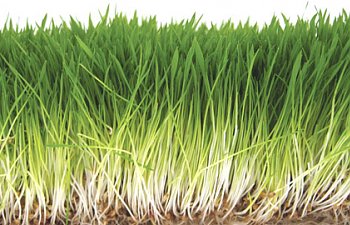
After soaking your seed just as you did with sprouting, transfer seeds to a tray. Set in a sunny area, preferably one that stays between 60-75 degrees. Rinse (or strain through a fine-mesh sieve the first few days) the seeds in fresh water and drain thoroughly 2-3 times a day. Roots will begin to grow on the underside while the green fodder starts to sprout out of the top. Once roots grow, try to dislodge the seeds as little as possible to allow a nice root base to form. Next, fill the tray with cool water and while holding the mad of fodder, tip over and drain. You don't want the entire thing sitting in water as this will cause mold to grow. If the air in your home is dry, you might cover the tray with a plastic wrap to hold in the moisture in between rinses. In about one week you should have enough growth to feed your chickens. Turn the fodder out of the tray and serve as is.
Homemade Feed mixes:
Would you rather make your flock a homemade feed mix? While it may be difficult to make your own feed, you might want to do some research into homemade feed mixes you can put together to feed your flock when bagged feed is not available. Whole grains can last a very long time if stored properly. There are many recipes on line, everybody has one. I also suggest you stop by the thread here on BYC on Homemade feed recipes, there are pages of ideas for you! https://www.backyardchickens.com/threads/everyone-post-your-best-homemade-chicken-feed-recipes.4477/
Alfalfa Hay:
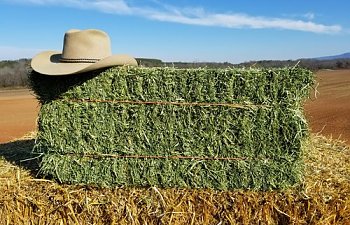
Alfalfa hay is a wonderful maintenance feed for all livestock. It is loaded with protein, vitamins, minerals and calcium for the hens. If stored properly, it will last years in a dry spot in your barn. When birds can't free range, throw a flake of Alfalfa in the run, they will entertain themselves all day long scratching for tiny seeds and eating the alfalfa leaves. Durng the winter months when there is little forage available, Alfalfa is a wonderful wholesome substitute. As stated above, it is LOADED with wonderful nutrients and is used as a maintenance feed for many livestock including chickens. Chickens are only going to go after the leaves which is where the nutrients are. I always purchase "3 strand" Alfalfa bales which generally will contain 80 to 90 percent leaves. I have found, at least in my area that "2 strand" bales can contain all stems with very little leaves so take a close look before buying. Purchase green bales only, no sun bleached yellow.
Fermenting grains:
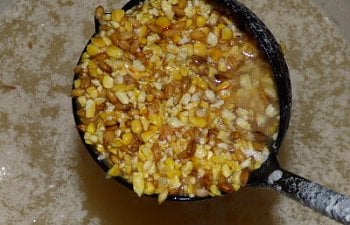
Basically fermented chicken feed is probiotics for your chickens. It’s a wet mash (the chicken keeper’s term for moistened food) created by lactic acid fermentation (the same type of fermentation that occurs naturally in sauerkraut). You will want to use Whole Grains only! The simple process of soaking the whole grains before feeding helps to release the stored nutrients by breaking the dormancy in the now softened whole grain. Soaking your grains greatly improves their digestibility by reducing the phytic acid and enzyme inhibitors found in all grains, seeds and legumes. Great ways to add bacteria and other beneficial yeasts. There are SO many ways to ferment feed and many mistakes can happen, so I am going to leave you with a link to a thread that has 895 pages of great ideas, help with the process, troubleshooting and all there is to know about Fermenting feeds. https://www.backyardchickens.com/threads/fermented-feeds-anyone-using-them.645057/#post-8695537
Hunting and Processing your own livestock back into your flock:
Do you or anyone in the house enjoy hunting? Deer, Rabbit, Elk and other wild creatures can be processed to feed your birds. Great protein! Processing your own livestock back into your flock is something you might also consider.
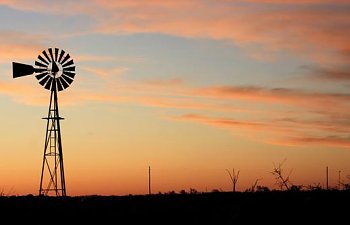
Closing comments:
If you are considering purchasing a few things in advance, I do recommend the Sea Kelp. Sea Kelp is an organic kelp meal, a valuable supplement that provides vitamins, minerals, amino acids and carbohydrates that in general, improve the overall health of chickens. A good poultry vitamin/mineral supplement will help your birds get through those hard times as well.
In trying times, we may not be able to feed them a perfect diet, but if we offer up enough of a variety of foods that contain all that they need, they should be able to get through the tough times. I hope this article has also given you some idea on poultry health and other additional food stuffs you might want to work into to your flock's daily diet! I am sure I missed a few subjects on these "Off the Grid Feeding Techniques" and you may have some additional ways to add to your flock's health too. Please feel free to share by leaving more suggestions in the comments below!!
May your flock be well!
Please visit the following links on our Treats Chart, Homemade Chicken Feeds, Fermenting Feeds, Sprouting seeds and growing Fodder and other great reads!
Treats Chart:
https://www.backyardchickens.com/articles/chicken-treat-chart—the-best-treats-for-backyard-chickens.47738/
Homemade Chicken Feed Recipes:
https://www.backyardchickens.com/threads/everyone-post-your-best-homemade-chicken-feed-recipes.4477/
Sprouts and Fodder:
https://www.backyardchickens.com/threads/growing-fodder.1208596/#post-19204049
Fermenting Feeds:
https://www.backyardchickens.com/threads/fermented-feeds-anyone-using-them.645057/#post-8695537
Definitely visit our Feeding your Flock forums for all kinds of threads and help!
https://www.backyardchickens.com/forums/feeding-watering-your-flock.12/

